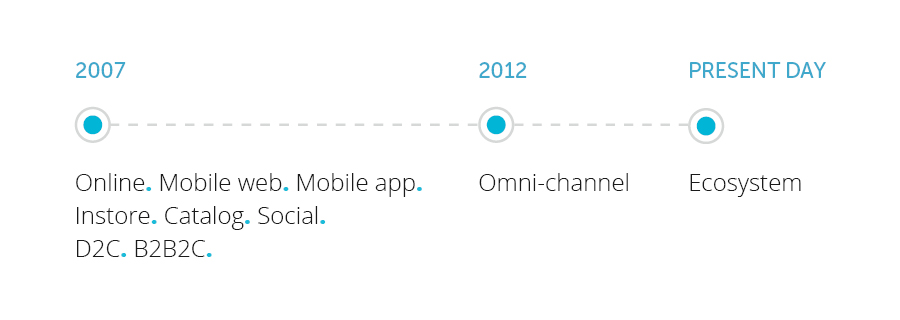If you Google, “Why does customer experience matter?” you’ll get 6,300,000 results in 0.65 seconds. On the first page alone you’ll see top results dating back to 2013 – practically a lifetime in the digital age. You’ll also see results from academia, consulting firms, boutique agencies, student projects – virtually everyone has an opinion on why customer experience matters. We won’t spend time debating its value now; let’s just agree customer experience matters more now than perhaps ever before. It’s what can set you apart from the rest of the pack, and in the best cases, it can be the differentiator that commands your customers’ loyalty.
Taking giant leaps towards improving your customer experience doesn’t have to be an expensive venture.
So what IS customer experience? There are thousands of definitions, but most center around one basic principle: it’s the customer’s interaction with your brand. Read on for three big ways to improve customer experience that require minimal up-front investment:
Maximize Your Existing Capabilities
I’ve met with clients so many times to discuss their “blue sky” goals – the goals they’d go after if they were not limited by their current constraints. Across organizations, it’s often the same obstacle to success – a lack of knowledge. So many organizations have moved towar ds digital at a breakneck pace, but they don’t realize the full power of the tools they have at their disposal. It’s not about knowing the tools at a more complex level; it’s about knowing the full breadth of the capabilities of your tools, and how you can leverage them to knock those goals out of the park.
Write down a few big goals, and start to think about how to approach them. Think less about the execution, and more about the desired outcome. With that list in hand, find your resident platform or solution expert (or your favorite agency or search engine) and ask them: how do we achieve these goals with our tools? This exercise may also uncover gaps, but chances are you have plenty of work to get started.
Build Your Personalization Engine
If you aren’t providing your users with a personalized experience, you’re missing a major opportunity – and you run the risk of getting eclipsed by the competition.
Personalization is everywhere and it’s not inherently digital; it’s your local coffee shop remembering your order when you get up to the cash register. Great personalization is rare; it’s your coffee shop having your order ready before you even walk in the door.
At its most basic level, personalization means taking information you have about an end user and using that information to customize their experience with your brand.
Personalization requires just three things to get started: end users (consumers, customers, visitors, etc.), data about those users, and a way to execute. All organizations have end users, whether internal associates or external customers. You also probably have more data than you think you do.
Whether online or offline, do you keep records of customers’ purchases at the individual level? Great – that’s usable data!
Do you have some level of insight when it comes to purchase behaviors, such as “people who bought X also bought Y?” Fantastic – that’s more usable data!
Do people set up preferences in their accounts on your site, or log in using their email before purchasing? You get the idea. The challenge I see most often is understanding how to bring that data together and then leverage it.
Many organizations have a personalization platform or capability already in their tech portfolios. If you don’t, there are a number of focused point solutions that may require an investment, but the investment would be minor compared to the return. Personalization isn’t a new concept or strategy; it’s been around since the dawn of retail and neighborhood stores. If you haven’t embraced it by now, it’s time.
Stop Thinking Omni-channel; Start Thinking Ecosystem

Omni-channel has become the norm, and more and more retailers are realizing the importance of connecting the consumers’ dots across their brand journeys. Whether providing customers with the convenience of click-and-collect or local inventory levels, blending channels makes a difference. Omni-channel is no longer cutting edge; it’s expected. And it will soon give way to the ecosystem.
A study from Kibo shows 80% of consumers are less likely to visit a store if they cannot see local inventory levels online.
Omni-channel was an evolution of silos; it connected the teams, efforts, and experiences across different channels into one. Oftentimes, this results in a related but not seamless experience. It’s as if you have a baseball team made up of really great individual players. You can have the best pitcher, the greatest catcher, and the best hitter in the league. If they don’t practice together, you might win. But it’s far from a guarantee.
The ecosystem is an evolution of omni-channel. It’s building a customer journey that transcends one specific channel with the understanding that your goal can no longer be a simple conversion. Your goal must be building out the customer-brand relationship and understanding how your customer is interacting with your brand at every touchpoint, pre- and post-purchase and across connected devices, including IoT and Artificial Intelligence tools, like voice-driven interactions.
While implementing changes that are born out of this shift in perspective may have an investment attached, the biggest step is the first and the cost is minimal: changing the perspective and the processes born of that perspective.
These small changes could have a profound impact on your organization. They also lay the foundation for more significant changes to your digital ecosystem. If you’re ready to commit to a more substantial investment related to digital transformation, consider organizing your thoughts with this guide from SoftServe expert Serhiy Haziyev, “Building a Business Case for the Digital Enterprise.”

